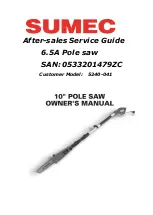
8
8
6. Remove any adjusting tools. Before operating the machine, make sure any adjusting tools
have been removed.
7. Blade Replacement. When replacing a blade, make sure the teeth face down and toward the
piece part. Properly tension the blade before operating the saw.
8. Piece Part Material. This band saw is designed to cut wood only. It is not designed to cut
metal or use cutting fluid.
9. Handling of Piece Part. NEVER hold small piece parts with your fingers when cutting. Always
feed the piece part with a feed stick and secure the material with clamping fixture, vise, or
table support as necessary.
10. Cutting Techniques. Plan your cuts so you always cut out of the wood. DO NOT back the
piece part away from the blade while the saw is running. If you need to back the work out,
turn the saw OFF and let the blade come to a complete stop. Never twist or put excessive
stress on the blade.
11. Keep work area clean. Cluttered areas invite injuries.
12. Overloading machine. By overloading the machine you may cause injury from flying parts.
DO NOT exceed the specified machine capacities.
13. Blade Control. DO NOT attempt to slow down or stop the blade with your hand or with a
piece part. Unless your saw is equipped with a brake,
allow the blade to stop on it’s own.
14. Dress appropriate. DO NOT wear loose fitting clothing or jewelry as they can be caught in
moving machine parts. Protective clothing and steel toe shoes are recommended when
using machinery. Wear a restrictive hair covering to contain long hair.
15. Feed Rate. ALWAYS feed the stock smoothly and evenly. DO NOT force or twist the blade
while cutting. Be especially careful when cutting piece parts with small radii.
16. Use eye and ear protection. Always wear ISO approved impact safety goggles.
17. Keep Hands Clear. ALWAYS use a brush, not your hands or fingers, to clear away chips and
dust.
18. Do not overreach. Maintain proper footing and balance at all times. DO NOT reach over or
across a running machine.
19. Stay alert. Watch what you are doing and use common sense. DO NOT operate any tool or
machine when you are tired.
20. Check for damaged parts. Before using any tool or machine, carefully check any part that
appears damaged. Check for binding of moving parts that may affect proper machine
operation.
21.
Observe work area conditions
.
DO NOT
use machines or power tools in damp or wet
locations. Do not expose to rain. Keep work area well lighted.
DO NOT
use electrically
powered tools in the presence of flammable gases or liquids.
22.
DO NOT
bypass or defeat any safety interlock systems.
Содержание WBS-12
Страница 28: ...26 26 PARTS DIAGRAM...
Страница 33: ...31 31 NOTES...
Страница 34: ...32 32 NOTES...
Страница 35: ...33 33 NOTES...











































